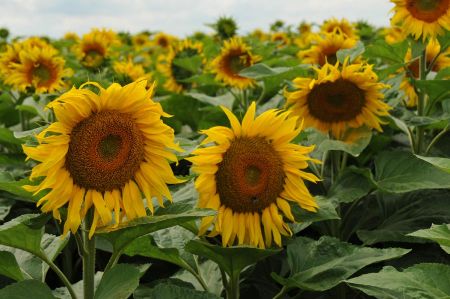Sunflowers - raw material for many different foods
- Written by Portal Editor
Right now again very much in the news an essential feature of sunflowers, cause they are used massively in advertising for a car brand: heliotropism. But what does it really mean?
Since the modern, electrically powered vehicle comes rushing from past the sunflower field and all the sunflowers follow the vehicle with their heads as if spellbound. Pure fiction and publicity stunt?
Not at all, because it is one of the special characteristics of the sunflower (Helianthus annuus), which belongs to the family of the daisy family, to turn to the sunlight. With the rising of the sun in the east, the bud follows the state of the sun to the west during the course of the day, then returns to its starting point at night and the game begins again. Even in advertising the entire plant follows the electric car with its "gaze", in nature it is only the leaves and buds that follow the course of the sun during the course of the day. The inflorescences itself usually points to the east where the sun rises. For this movement of the plant, cells are responsible, which sit below the bud and act as a motor and provide the movement.
Where do sunflowers come from?
The sunflowers are native to North and Central America, where they were cultivated as early as around 2500 BC, predominantly in the Mississippi and Mexico City regions. Sailor Francisco Pizarro was able to observe Indians of the Inca tribe, who worshiped the sunflowers because they were worshiped as the image of a god. For the first time after the return of the sailors to Europe, seeds and drawings of the sunflower came here in 1552. At the time, however, sunflowers were considered to be ornamental plants.
How sunflowers are cultivated today
With the discovery of sunflower as an oil plant the large-scale cultivation in the agricultural industry began. The main growing areas for sunflowers today are China, the United States, Russia, Ukraine, Turkey and the rest of Europe. To grow the sunflower requires humus and nutrient-rich soil, sufficient supply of water and heat. In the agricultural industry, the sowing is done automatically by machines with a row spacing of 75 centimeters and a distance of 45 centimeters between the plants. For example, about 6 - 7 plants per square meter are set, which then yield 60,000 - 70,000 sunflowers per hectare. If the first leaves die off in the fall, that means harvesting time, which mostly takes place with slightly different combine harvests.
Sunflower oil used in different fields
Sunflower in greek mythology
As is usual with many plants, the origin name of the sunflower is derived from the Greek: helios for sun and anthos for flower. And as usual with the Greeks, this is due to a mythology reference, the truth of which seems far-fetched, even on the basis of modern knowledge:
The girl Clythia fell in love with the god of light Apollon, who did not return that love. Then Clythia sat completely naked on a rock by the sea, did not eat and drink any more and despaired of life. For nine days every night Clythia watched Apollo as he moved his vehicle across the sky, following him with his gaze over the starry sky. Then her suffering became so great that she withered and assumed yellow and brown color. She turned into a withering sunflower that had been following her eyes for days with Apollo's sun-chariot.
Please read as well:
Wild alpine violet - this plant has lot of secrets
Strawberry tree - flower and fruit at the same time
